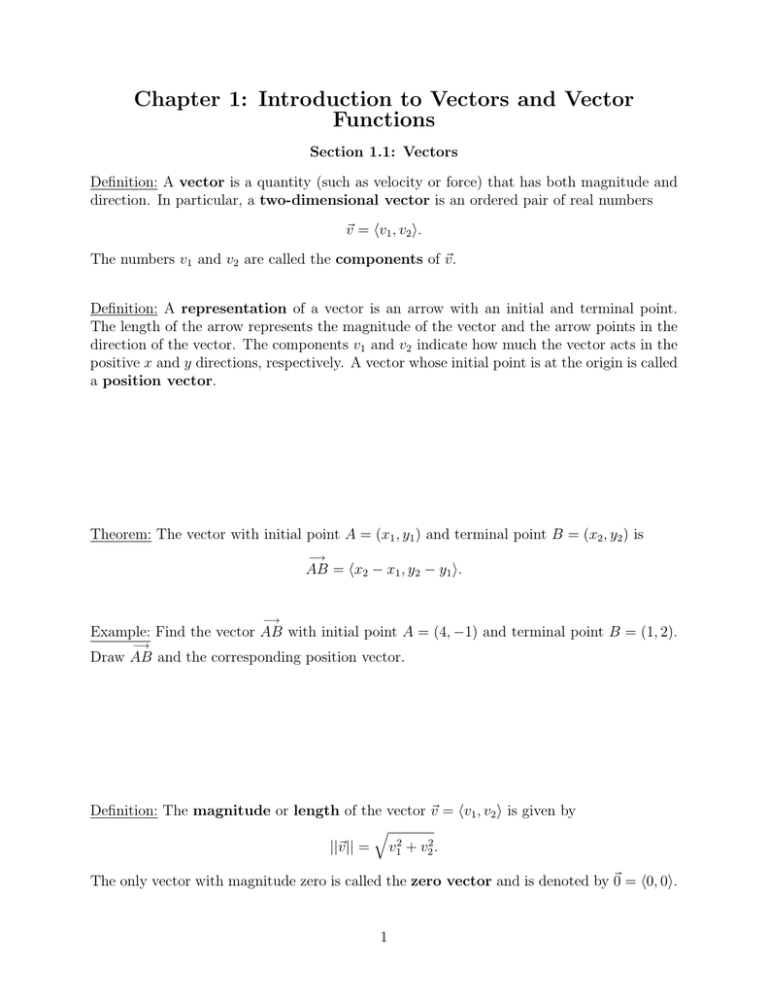Chapter 1: Introduction to Vectors and Vector Functions
advertisement

Chapter 1: Introduction to Vectors and Vector Functions Section 1.1: Vectors Definition: A vector is a quantity (such as velocity or force) that has both magnitude and direction. In particular, a two-dimensional vector is an ordered pair of real numbers ~v = hv1 , v2 i. The numbers v1 and v2 are called the components of ~v . Definition: A representation of a vector is an arrow with an initial and terminal point. The length of the arrow represents the magnitude of the vector and the arrow points in the direction of the vector. The components v1 and v2 indicate how much the vector acts in the positive x and y directions, respectively. A vector whose initial point is at the origin is called a position vector. Theorem: The vector with initial point A = (x1 , y1 ) and terminal point B = (x2 , y2 ) is −→ AB = hx2 − x1 , y2 − y1 i. −→ Example: Find the vector AB with initial point A = (4, −1) and terminal point B = (1, 2). −→ Draw AB and the corresponding position vector. Definition: The magnitude or length of the vector ~v = hv1 , v2 i is given by q ||~v || = v12 + v22 . The only vector with magnitude zero is called the zero vector and is denoted by ~0 = h0, 0i. 1 Theorem: (Vector Algebra) Suppose that ~v = hv1 , v2 i and w ~ = hw1 , w2 i are vectors and c is a scalar (real number). 1. Scalar Multiplication: The vector c~v is defined by c~v = hcv1 , cv2 i. Geometrically, scalar multiplication is represented by scaling the magnitude of ~v and/or reversing its direction. 2. Vector Addition: The vector ~v + w ~ is defined by ~v + w ~ = hv1 + w1 , v2 + w2 i. Geometrically, vector addition is represented by the Triangle or Parallelogram Laws. 3. Vector Subtraction: The vector ~v − w ~ is defined by ~v − w ~ = hv1 − w1 , v2 − w2 i. A geometric representation of vector subtraction is given below. 2 Example: Given ~v = h−1, 2i and w ~ = h4, 3i, find (a) 3~v + 4w ~ (b) ||~v − w|| ~ Definition: A unit vector is a vector with magnitude one. If ~v 6= ~0, then a unit vector in the direction of ~v is given by ~v 1 ~u = = ~v . ||~v || ||~v || Example: Find a unit vector in the direction of ~v = h3, −2i. Definition: The unit vectors ~i = h1, 0i and ~j = h0, 1i that point in the directions of the positive x and y axes are called the standard basis vectors. Note: Any vector ~v = hv1 , v2 i can be expressed in terms of the standard basis vectors as ~v = v1~i + v2~j. 3 Example: Consider the vectors ~a = h3, 2i, ~b = h5, −1i, and ~c = h7, 2i. Find scalars s and t such that s~a + t~b = ~c. The direction of a vector is often defined in terms of the angle it forms, measured from the positive x-axis. Suppose that the vector ~r = hx, yi forms the angle θ, measured from the positive x-axis. It follows that cos θ = x ||~r|| sin θ = x = ||~r|| cos θ y ||~r|| y = ||~r|| sin θ. Therefore, the vector ~r can be expressed as ~r = h||~r|| cos θ, ||~r|| sin θi. Example: Find the components of the vector ~r such that (a) ||~r|| = 4 and ~r makes an angle of 60◦ with the positive x-axis. (b) ||~r|| = 5 and ~r makes an angle of 150◦ with the positive x-axis. 4 Applications to Physics and Engineering A force is represented by a vector since it has both a magnitude (measured in pounds or newtons) and a direction. If several forces are acting on an object, the resultant force experienced by the object is the sum of these forces. Example: Two forces F~1 and F~2 with magnitudes 10 lb and 12 lb act on an object at a point P as shown in the figure below. Find the resultant force F~ acting on P as well as its magnitude and direction. 5 Example: A woman walks due west on the deck of a ship at 3 mph. The ship is moving north at a speed of 22 mph. Find the speed and direction of the woman relative to the surface of the water. Example: Suppose that a wind is blowing from the direction N45◦ W at a speed of 50 km/h. A pilot is steering a plane in the direction N60◦ E at an airspeed (speed in still air) of 250 km/h. Find the true course (direction of the resultant vector) and the ground speed (magnitude of the resultant vector) of the plane. 6 Example: An 80 lb weight hangs from two wires as shown in the figure below. 60 30 80 lbs Find the tension in each wire and the magnitude of the tension. 7



